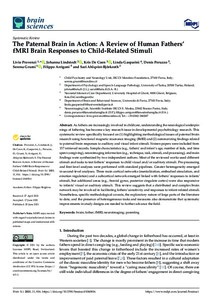The Paternal Brain in Action: A Review of Human Fathers' fMRI Brain Responses to Child-Related Stimuli
Provenzi Livio; Lindstedt Johanna; De Coen Kris; Gasparini Linda; Peruzzo Denis; Grumi Serena; Arrigoni Filippo; Ahlqvist-Björkroth Sari
The Paternal Brain in Action: A Review of Human Fathers' fMRI Brain Responses to Child-Related Stimuli
Provenzi Livio
Lindstedt Johanna
De Coen Kris
Gasparini Linda
Peruzzo Denis
Grumi Serena
Arrigoni Filippo
Ahlqvist-Björkroth Sari
MDPI
Julkaisun pysyvä osoite on:
https://urn.fi/URN:NBN:fi-fe2021093048422
https://urn.fi/URN:NBN:fi-fe2021093048422
Tiivistelmä
As fathers are increasingly involved in childcare, understanding the neurological underpinnings of fathering has become a key research issue in developmental psychobiology research. This systematic review specifically focused on (1) highlighting methodological issues of paternal brain research using functional magnetic resonance imaging (fMRI) and (2) summarizing findings related to paternal brain responses to auditory and visual infant stimuli. Sixteen papers were included from 157 retrieved records. Sample characteristics (e.g., fathers' and infant's age, number of kids, and time spent caregiving), neuroimaging information (e.g., technique, task, stimuli, and processing), and main findings were synthesized by two independent authors. Most of the reviewed works used different stimuli and tasks to test fathers' responses to child visual and/or auditory stimuli. Pre-processing and first-level analyses were performed with standard pipelines. Greater heterogeneity emerged in second-level analyses. Three main cortical networks (mentalization, embodied simulation, and emotion regulation) and a subcortical network emerged linked with fathers' responses to infants' stimuli, but additional areas (e.g., frontal gyrus, posterior cingulate cortex) were also responsive to infants' visual or auditory stimuli. This review suggests that a distributed and complex brain network may be involved in facilitating fathers' sensitivity and responses to infant-related stimuli. Nonetheless, specific methodological caveats, the exploratory nature of large parts of the literature to date, and the presence of heterogeneous tasks and measures also demonstrate that systematic improvements in study designs are needed to further advance the field.
Kokoelmat
- Rinnakkaistallenteet [27094]
